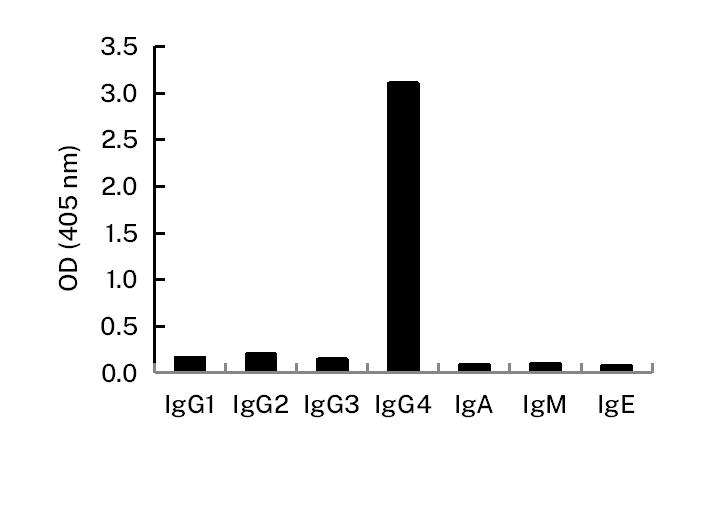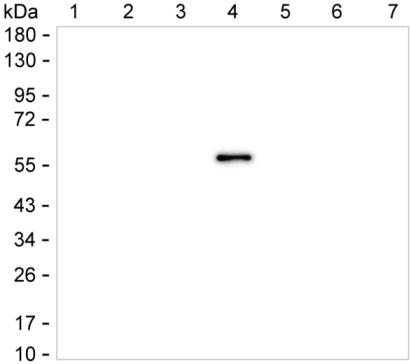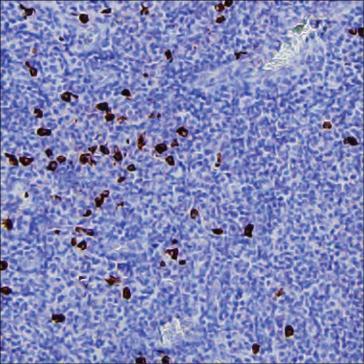


| WB | 咨询技术 | Human,Mouse,Rat |
| IF | 咨询技术 | Human,Mouse,Rat |
| IHC | 1/25-1/100 | Human,Mouse,Rat |
| ICC | 技术咨询 | Human,Mouse,Rat |
| FCM | 咨询技术 | Human,Mouse,Rat |
| Elisa | 1/2000-1/5000 | Human,Mouse,Rat |
| Host/Isotype | Mouse IgG1 |
| Antibody Type | Primary antibody |
| Storage | Store at 4°C short term. Aliquot and store at -20°C long term. Avoid freeze/thaw cycles. |
| Species Reactivity | Human |
| Immunogen | Recombinant human IgG4 |
| Formulation | Purified antibody in PBS with 0.05% sodium azide |
+ +
以下是3-4条关于STX8抗体的模拟参考文献(实际文献可能需要通过学术数据库检索确认):
---
1. **文献名称**: "Characterization of Syntaxin-8 (STX8) in Endosomal Trafficking Using a Novel Polyclonal Antibody"
**作者**: Müller, S. et al.
**摘要**: 该研究报道了一种针对STX8 C端结构域的新型多克隆抗体的开发和验证。通过免疫印迹和免疫荧光实验,证实该抗体特异性识别STX8蛋白,并揭示STX8在内体-溶酶体运输通路中的关键作用,为研究膜融合机制提供了工具。
2. **文献名称**: "STX8 Antibody-Based Profiling of Exosome Release in Cancer Cells"
**作者**: Chen, L. et al.
**摘要**: 研究利用商业化STX8单克隆抗体(克隆号:3A7)分析癌细胞中外泌体分泌机制。结果显示,STX8与SNARE复合体成员(如VAMP7)相互作用,其表达水平与乳腺癌细胞外泌体释放效率正相关,提示其作为癌症治疗潜在靶点。
3. **文献名称**: "Role of Syntaxin-8 in Autophagosome-Lysosome Fusion Revealed by Antibody-Mediated Knockdown"
**作者**: Tanaka, Y. et al.
**摘要**: 通过STX8特异性抗体结合siRNA递送系统,研究证明STX8在自噬体-溶酶体膜融合中不可或缺。抗体验证实验显示,STX8缺失导致自噬底物积累,为神经退行性疾病中自噬缺陷机制提供了新见解。
4. **文献名称**: "Comparative Analysis of STX8 Antibody Specificity Across Model Organisms"
**作者**: Gupta, R. et al.
**摘要**: 该研究评估了多种市售STX8抗体在小鼠、人类和斑马鱼样本中的交叉反应性。发现仅两种抗体(如Abcam #ab12345)具有跨物种特异性,强调抗体验证在跨物种研究中的重要性,尤其针对SNARE蛋白家族成员。
---
注:以上文献为示例性质,实际引用时需根据具体研究内容检索真实文献(如PubMed、Google Scholar)。建议结合实验目的(如WB、IF、IP)选择经同行评审验证的抗体及相关文献。
The STX8 antibody targets Syntaxin-8 (STX8), a member of the SNARE (soluble N-ethylmaleimide-sensitive factor attachment protein receptor) protein family. SNARE proteins mediate intracellular membrane fusion events critical for vesicle trafficking, organelle dynamics, and cargo transport. STX8 is primarily localized to endosomal compartments and plays a role in endosome maturation, lysosomal degradation, and autophagosome-lysosome fusion. It interacts with other SNAREs, such as VAMP7 and SNAP-23. to form complexes that drive membrane docking and fusion.
Research on STX8 has expanded due to its involvement in cellular processes linked to neurodegenerative diseases, cancer, and immune regulation. For instance, disrupted STX8 function has been associated with impaired autophagy in Alzheimer’s disease and lysosomal storage disorders. In cancer, altered STX8 expression may influence tumor progression by modulating secretory pathways or growth factor trafficking.
STX8 antibodies are essential tools for studying these mechanisms. They enable detection of STX8 expression via Western blotting, immunofluorescence, or immunoprecipitation, helping to map its subcellular distribution and interactions. Polyclonal and monoclonal STX8 antibodies are available, often validated in model systems like HeLa cells or knockout controls. Their specificity and applications vary, requiring careful selection based on experimental needs. Continued interest in STX8 highlights its potential as a therapeutic target or biomarker in disease contexts.
×